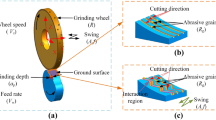Abstract
In order to mitigate the problems in CNC grinding of a camshaft caused by varying grinding depth along the periphery of the cam, a novel grinding strategy is proposed to keep the grinding depth constant during the process. In comparison with the current cam grinding strategy, analysis results derived from the modelling of the process indicate that it is applicable to keep the grinding depth constant. Consequently, in combination with a constant grinding infeed speed, the material removal rate (MRR) is also kept stable. With the same grinding depth, the volume of removed material in a certain single revolution with the new processing strategy is less than the conventional process. This new strategy can increase the grinding depth without causing grinding burns. Therefore, the total number of grinding revolutions/steps decreases dramatically. Moreover, experiments for comparison of both the single revolution machining and the whole cam grinding have been carried out on a CNC8325B camshaft grinder. The results show that the new process improves machining efficiency dramatically while ensuring the machining quality.
Similar content being viewed by others
References
Inaba S, Automatically controlled cam grinding system, US Patents, 3,482,357, 1969
Portas G, Perkins D, Crookall J (1983) A high performance CNC machine for grinding camshaft profiles. CIRP Anns-Manuf Technol 32(1):331–333
Jackson M, Davis C, Hitchiner M, Mills B (2001) High-speed grinding with CBN grinding wheels—applications and future technology. J Mater Process Technol 110(1):78–88
Oliveira J, Silva E, Guo C, Hashimoto F (2009) Industrial challenges in grinding. CIRP Anns-Manuf Technol 58(2):663–680
Katsumi Y, Matsuda S, Inano T, Cam grinding apparatus with means to maintain the grinding speed constant, US Patents 4,102,082, 1978
Wu D, Chen K, Wang XK (2009) An investigation of practical application of variable spindle speed machining to noncircular turning process. J Adv Manuf Technol 44(11–12):1094–1105
Frank A, Schmid A (1988) Grinding of non-circular contours on CNC cylindrical grinding machines. Robot Comput Integr Manuf 4(1):211–218
Norton RL (1988) Effect of manufacturing method on dynamic performance of cams—an experimental study, part I—eccentric cams. Mech Mach Theory 23(3):191–199
Norton RL (1988) Effect of manufacturing method on dynamic performance of cams—an experimental study, Part II—double dwell cams. Mech Mach Theory 23(3):201–208
Deng ZH, Zhang XH, Liu W, Cao H (2009) A hybrid model using genetic algorithm and neural network for process parameters optimization in NC camshaft grinding. Int J Adv Manuf Technol 45(9–10):859–866
Zhang XH, An WK, Cao H (2012) An expert system of cubic boron nitride (CBN) grinding wheel dressing in cam grinding. Mater Manuf Process 27(10):1095–1100
Zhang XH, Deng ZH, An WK, Cao H (2013) A methodology for contour error intelligent precompensation in cam grinding. Int J Adv Manuf Technol 64(1–4):165–170
Zhang XH, Deng ZH, Liu W, Cao H (2013) Combining rough set and case based reasoning for process conditions selection in camshaft grinding. J Intell Manuf 24(2):211–224
Satyanarayana B, Rao PN, Tewari NK (1988) Machining of plate cam profiles on CNC machine tools using a highly integrated part programming system. Int J Adv Manuf Technol 3(4):105–125
Lee RS, Lee NJ (2001) A new tool-path generation method using a cylindrical end mill for 5-axis machining of a spatial cam with a conical meshing element. Int J Adv Manuf Technol 18(9):615–623
Wedeniwski HJ, Process and device for numerically controlled grinding of cams of a camshaft, US Patents 5,392,566, 1995
Author information
Authors and Affiliations
Corresponding authors
Rights and permissions
About this article
Cite this article
Tang, H., Deng, Z.H., Guo, Y.S. et al. Research on constant grinding depth model for cam grinding. Int J Adv Manuf Technol 74, 351–359 (2014). https://doi.org/10.1007/s00170-014-5993-2
Received:
Accepted:
Published:
Issue Date:
DOI: https://doi.org/10.1007/s00170-014-5993-2




